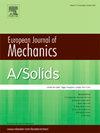Change of microstructure and mechanical state in nano-sized wiredrawing: Molecular dynamics simulation of pure magnesium
IF 4.4
2区 工程技术
Q1 MECHANICS
引用次数: 0
Abstract
Microstructural changes of single-crystal and polycrystal pure magnesium (Mg) during wiredrawing process are studied using molecular dynamics (MD). Twinning, dislocation motions and microstructural changes are discussed. Miniaturized wiredrawing simulation is realized to mimic realistic three-dimensional drawing process of Mg and Mg alloys, where a conical and tapered die is placed and the wire is introduced in the die by applying velocity at both ends of the wire. The interatomic interaction by embedded atom method (EAM) for pure Mg is used, partly modifying in order to represent a sufficient lubrication between wire and die. For single-crystal, simulations changing crystal orientation for drawing direction are performed. For polycrystal, grain size and wire diameter are changed and compared. In single crystal models, a twinning having the same orientation occurs during drawing, except for the case dominated by slips on basal planes. In polycrystal simulations, the results show that plastic deformation of Mg wire consists of three atomistic mechanisms: (1) grain boundary sliding, (2) twinning, and (3) dislocation slip on basal plane. The occurrence of these behaviors strongly depends on grain sizes and a combination of the mechanism could be summarized for grain diameter between 2–40 nm. It is also found that a microstructure showing a typical texture is obtained for polycrystal models like that experimentally observed in drawn Mg wires. These analyses are successfully conducted by helpful post-analyses for MD such as polyhedral-template-matching (PTM) method and dislocation extraction algorithm (DXA), as well as newly-introduced Neo-Eulerian mapping (NEmap).
求助全文
约1分钟内获得全文
求助全文
来源期刊
CiteScore
7.00
自引率
7.30%
发文量
275
审稿时长
48 days
期刊介绍:
The European Journal of Mechanics endash; A/Solids continues to publish articles in English in all areas of Solid Mechanics from the physical and mathematical basis to materials engineering, technological applications and methods of modern computational mechanics, both pure and applied research.

 求助内容:
求助内容: 应助结果提醒方式:
应助结果提醒方式:


